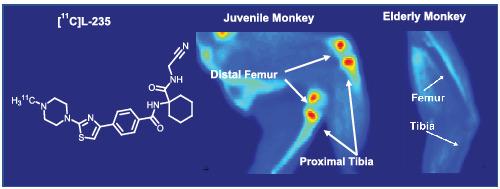当前位置:
X-MOL 学术
›
J. Label. Comp. Radiopharm.
›
论文详情
Our official English website, www.x-mol.net, welcomes your feedback! (Note: you will need to create a separate account there.)
Preclinical evaluation of [11C]L‐235 as a radioligand for Positron Emission Tomography cathepsin K imaging in bone
Journal of Labelled Compounds and Radiopharmaceuticals ( IF 1.8 ) Pub Date : 2020-11-23 , DOI: 10.1002/jlcr.3896 Idriss Bennacef 1 , Daniel Rubins 1 , Kerry Riffel 1 , Mangay Williams 1 , Diane J Posavec 1 , Marie A Holahan 1 , Mona L Purcell 1 , Hyking D Haley 1 , Mary Wolf 1 , Shawn J Stachel 2 , Laura S Lubbers 3 , Gregg A Wesolowski 4 , Le T Duong 4 , Terence G Hamill 1 , Jeffrey L Evelhoch 1 , Eric D Hostetler 1
Journal of Labelled Compounds and Radiopharmaceuticals ( IF 1.8 ) Pub Date : 2020-11-23 , DOI: 10.1002/jlcr.3896 Idriss Bennacef 1 , Daniel Rubins 1 , Kerry Riffel 1 , Mangay Williams 1 , Diane J Posavec 1 , Marie A Holahan 1 , Mona L Purcell 1 , Hyking D Haley 1 , Mary Wolf 1 , Shawn J Stachel 2 , Laura S Lubbers 3 , Gregg A Wesolowski 4 , Le T Duong 4 , Terence G Hamill 1 , Jeffrey L Evelhoch 1 , Eric D Hostetler 1
Affiliation

|
The cathepsin K (CatK) enzyme is abundantly expressed in osteoclasts, and CatK inhibitors have been developed for the treatment of osteoporosis. In our effort to support discovery and clinical evaluations of a CatK inhibitor, we sought to discover a radioligand to determine target engagement of the enzyme by therapeutic candidates using positron emission tomography (PET). L‐235, a potent and selective CatK inhibitor, was labeled with carbon‐11. PET imaging studies recording baseline distribution of [11C]L‐235, and chase and blocking studies using the selective CatK inhibitor MK‐0674 were performed in juvenile and adult nonhuman primates (NHP) and ovariectomized rabbits. Retention of the PET tracer in regions expected to be osteoclast‐rich compared with osteoclast‐poor regions was examined. Increased retention of the radioligand was observed in osteoclast‐rich regions of juvenile rabbits and NHP but not in the adult monkey or adult ovariectomized rabbit. Target engagement of CatK was observed in blocking studies with MK‐0674, and the radioligand retention was shown to be sensitive to the level of MK‐0674 exposure. [11C]L‐235 can assess target engagement of CatK in bone only in juvenile animals. [11C]L‐235 may be a useful tool for guiding the discovery of CatK inhibitors.
中文翻译:

[11C]L-235 作为放射性配体用于骨中正电子发射断层扫描组织蛋白酶 K 成像的临床前评价
组织蛋白酶 K (CatK) 酶在破骨细胞中大量表达,CatK 抑制剂已被开发用于治疗骨质疏松症。在我们支持 CatK 抑制剂的发现和临床评估的努力中,我们试图发现一种放射性配体,以使用正电子发射断层扫描 (PET) 确定治疗候选者对酶的靶标参与。L-235 是一种有效的选择性 CatK 抑制剂,用碳 11 标记。PET 成像研究记录 [ 11C]L-235,以及使用选择性 CatK 抑制剂 MK-0674 的追踪和阻断研究在幼年和成年非人类灵长类动物 (NHP) 和去卵巢的兔子中进行。与破骨细胞贫乏区域相比,研究了在预期富含破骨细胞的区域中 PET 示踪剂的保留情况。在幼年兔和 NHP 的富含破骨细胞的区域中观察到放射性配体的保留增加,但在成年猴或成年卵巢切除兔中未观察到。在 MK-0674 的阻断研究中观察到 CatK 的靶标接合,并且显示放射性配体保留对 MK-0674 暴露水平敏感。[ 11 C]L-235 只能在幼年动物中评估 CatK 在骨骼中的目标接合。[ 11 C]L-235 可能是指导发现 CatK 抑制剂的有用工具。
更新日期:2020-11-23
中文翻译:

[11C]L-235 作为放射性配体用于骨中正电子发射断层扫描组织蛋白酶 K 成像的临床前评价
组织蛋白酶 K (CatK) 酶在破骨细胞中大量表达,CatK 抑制剂已被开发用于治疗骨质疏松症。在我们支持 CatK 抑制剂的发现和临床评估的努力中,我们试图发现一种放射性配体,以使用正电子发射断层扫描 (PET) 确定治疗候选者对酶的靶标参与。L-235 是一种有效的选择性 CatK 抑制剂,用碳 11 标记。PET 成像研究记录 [ 11C]L-235,以及使用选择性 CatK 抑制剂 MK-0674 的追踪和阻断研究在幼年和成年非人类灵长类动物 (NHP) 和去卵巢的兔子中进行。与破骨细胞贫乏区域相比,研究了在预期富含破骨细胞的区域中 PET 示踪剂的保留情况。在幼年兔和 NHP 的富含破骨细胞的区域中观察到放射性配体的保留增加,但在成年猴或成年卵巢切除兔中未观察到。在 MK-0674 的阻断研究中观察到 CatK 的靶标接合,并且显示放射性配体保留对 MK-0674 暴露水平敏感。[ 11 C]L-235 只能在幼年动物中评估 CatK 在骨骼中的目标接合。[ 11 C]L-235 可能是指导发现 CatK 抑制剂的有用工具。


























 京公网安备 11010802027423号
京公网安备 11010802027423号